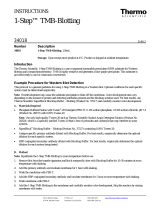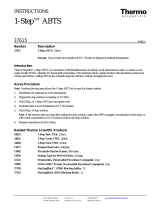Page is loading ...

INSTRUCTIONS
Pierce Biotechnology
PO Box 117
(815) 968-0747
www.thermoscientific.com/pierce
3747 N. Meridian Road
Rockford, lL 61105 USA
(815) 968-7316 fax
Number Description
34001 DAB (3,3´-diaminobenzidine tetrahydrochloride), 10g
Storage: Upon receipt store product at -20°C protected from moisture. Product is shipped at ambient
temperature.
34002 DAB Substrate Kit
Kit Contents:
DAB Solution (10X), 25mL
Stable Peroxide Substrate Buffer, 250mL
Storage: Upon receipt store kit at 4°C. Kit is shipped at ambient temperature.
Introduction
The Thermo Scientific DAB (3,3´-diaminodbenzidine) is a sensitive colorimetric substrate used with horseradish peroxidase
(HRP) in immunohistochemistry and immunoblotting applications. HRP catalyzes hydrogen peroxide oxidation of substrates
such as DAB. Electrons are transferred by HRP from the DAB to the peroxide to yield an insoluble brown product.
Note: Please refer to the material safety data sheet for DAB handling information.
Example Procedure for Immunohistochemical Staining
This protocol is a general guideline for using DAB in an immunohistochemical application. Optimal conditions for each
specific system must be determined empirically.
A. Important Procedural Notes
• To minimize potential microbial contamination, carefully handle reagents and use ultrapure water in all solutions.
• Do not use sodium azide as a preservative for buffers. Sodium azide inhibits HRP activity and could interfere with
detection.
• Discard diluted and used solutions along with excess buffer after use. Do not reuse solutions.
• To prevent evaporation, use a humidity chamber set at 20-25°C for incubations. Additionally, completely cover the
tissue section with solution during incubations to prevent drying. For overnight incubations, completely submerge slides
and incubate at 2-8°C.
• Avoid touching slides and do not allow dust or other debris to contaminate samples, tissues or other material.
• Adjust the standard protocol when antigen concentrations are too high or low. High antigen concentrations will require
less incubation time to obtain optimal staining. To shorten incubation times, increase incubation temperature to 37°C.
• An ABC complex system such as the Thermo Scientific ABC Standard Peroxidase Staining Kit (Product No. 32020) or
Ultra-Sensitive ABC Standard Peroxidase Staining Kit (Product No. 32050) can increase sensitivity if necessary.
0142.3
34001 34002
DAB Substrate

Pierce Biotechnology
PO Box 117
(815) 968-0747
www.thermoscientific.com/pierce
3747 N. Meridian Road
Rockford, lL 61105 USA
(815) 968-7316 fax
2
B. Materials Required
• Cryostat sections fixed in acetone for 10 minutes and air-dried.
Note: Paraffin sections must be de-paraffinated with xylene and rehydrated with descending ethanol washes. If picric
acid was used during fixation, incubate overnight in PBS followed by several PBS washes.
• Phosphate Buffered Saline with Tween™-20 Detergent (PBS-T): 0.1M sodium phosphate, 0.15M sodium chloride; pH
7.2 (Product No. 28372) with 0.05% Tween-20
Note: Use only high-quality Tween-20, such as Thermo Scientific Surfact-Amps Detergent Solution (Product No.
28320), which is a specially purified Tween-20 that is free of peroxides and carbonyls that may interfere with some
systems.
• Blocking Buffer: Normal serum with 0.05% Tween-20, Thermo Scientific™ StartingBlock™ (PBS) Blocking Buffer
(Product No. 37538) with 0.05% Tween-20 or StartingBlock T20 (PBS) Blocking Buffer (Product No. 37539), which is
pre-formulated with Tween-20
• Antigen-specific primary antibody diluted with Blocking Buffer. For best results, empirically determine the optimal
dilution for each specific tissue/antigen type being tested.
• HRP-conjugated secondary antibody diluted with Blocking Buffer. For best results, empirically determine the optimal
dilution for each system being tested.
• DAB Substrate: DAB is supplied either as a powder or a 10X solution.
• For the powder, allow the bottle to warm to room temperature before opening. Dissolve DAB in 50mM Tris, pH 7.2
at 1mg/mL. Immediately before use, add an equal volume of 0.02% hydrogen peroxide.
• For the 10X DAB solution, immediately before use, combine 2.5mL of DAB with 22.5mL of the Stable Peroxide
Substrate Buffer and mix thoroughly.
C. Method
1. Quench endogenous peroxidase activity by incubating tissue for 30 minutes in Thermo Scientific Peroxidase Suppressor
(Product No. 35000) or 0.3% hydrogen peroxide in methanol.
Note: Omit this step if endogenous activity is not a problem or if the antigen will not survive exposure to H2O2.
2. Wash tissue with PBS-T.
3. Add Blocking Buffer and incubate for 30-60 minutes at room temperature.
Note: Use a humidity chamber set at 20-25°C for all incubations to prevent evaporation. Additionally, completely cover
the tissue section during incubations with solution to prevent drying.
4. Incubate tissue with the primary antibody for 30-90 minutes.
5. Wash tissue three times for 10 minutes each with PBS-T.
6. Incubate slide with HRP-labeled secondary antibody for 30 minutes.
7. Wash slide three times for 10 minutes each with PBS-T.
8. Add the hydrogen peroxide to the DAB solution (see Materials Required Section). Add the substrate solution to the
sections and incubate for 2-7 minutes.
9. Wash slide two times for 3 minutes each with PBS-T. Counterstain if desired.
10. Mount slides and add a coverslip to the section after it has dried.
Note: For optimal photographic images, turn the slide upside down and place on absorbent paper. Use gentle pressure to
expel excess mounting medium, wipe the edge of the slide, and seal the coverslip with clear nail polish. This procedure will
produce tissue uniformity and result in optimal photographs.

Pierce Biotechnology
PO Box 117
(815) 968-0747
www.thermoscientific.com/pierce
3747 N. Meridian Road
Rockford, lL 61105 USA
(815) 968-7316 fax
3
Example Procedure for Western Blot Detection
This protocol is a general guideline for using DAB for Western blot detection. Optimal conditions for each specific system
must be determined empirically.
A. Materials Required
• Membrane containing transferred proteins
• Phosphate Buffered Saline with Tween-20 (PBS-T): 0.1M sodium phosphate, 0.15M sodium chloride; pH 7.2 (Product
No. 28372) with 0.05% Tween-20
Note: Use only high-quality Tween-20 such as Surfact-Amps Detergent Solution (Product No. 28320), which is a
specially purified Tween-20 that is free of peroxides and carbonyls that may interfere with some systems.
• Blocking Buffer: StartingBlock (PBS) Blocking Buffer (Product No. 37538) with 0.05% Tween-20 or StartingBlock T20
(PBS) Blocking Buffer (Product No. 37539), which is pre-formulated with Tween-20
• Antigen-specific primary antibody diluted with Blocking Buffer. Empirically determine the optimal dilution for each
specific system.
• HRP-conjugated secondary antibody diluted with Blocking Buffer. Empirically determine the optimal dilution for each
system being tested.
• DAB Substrate: DAB is supplied either as a powder or a 10X solution.
• For the powder, allow the bottle to warm to room temperature before opening. Dissolve DAB in 50mM Tris, pH 7.2
at 1mg/mL. Immediately before use, add an equal volume of 0.02% hydrogen peroxide.
• For the 10X DAB solution, immediately before use, combine 2.5mL of DAB with 22.5mL of the Stable Peroxide
Substrate Buffer and mix thoroughly.
B. Procedure
1. Add Blocking Buffer to the membrane and incubate for 10-30 minutes at room temperature with shaking.
2. Decant the Blocking Buffer. Add the primary antibody and incubate membrane for 1 hour with shaking.
3. Wash the membrane with PBS-T
4. Add the HRP-conjugated secondary antibody and incubate membrane for 1 hour at room temperature with shaking.
5. Wash membrane with PBS-T.
6. Add the hydrogen peroxide to the DAB solution (see Materials Required Section). Add the DAB Substrate Solution to
the membrane and incubate until the desired development is achieved. Typical incubations are from 5 to 15 minutes.
Related Thermo Scientific Products
35000 Peroxidase Suppressor, 100mL
28320 Tween-20 Surfact-Amps Detergent Solution, 6 × 10mL
34065 Metal Enhanced DAB Substrate Kit
32020 ABC Standard Peroxidase Staining Kit, contains avidin and biotinylated HRP
88013 Nitrocellulose Membrane, 0.2µm, 7.9 × 10.5cm, 15 sheets/pkg
37538 StartingBlock™ (PBS) Blocking Buffer, 1L
37542 StartingBlock (TBS) Blocking Buffer, 1L
37528 Blocker™ Casein in PBS, 1L
37530 Blocker BLOTTO in TBS, 1L
37520 Blocker BSA in TBS (10X), 125mL

Pierce Biotechnology
PO Box 117
(815) 968-0747
www.thermoscientific.com/pierce
3747 N. Meridian Road
Rockford, lL 61105 USA
(815) 968-7316 fax
4
Products are warranted to operate or perform substantially in conformance with published Product specifications in effect at the time of sale, as set forth in
the Product documentation, specifications and/or accompanying package inserts (“Documentation”). No claim of suitability for use in applications regulated
by FDA is made. The warranty provided herein is valid only when used by properly trained individuals. Unless otherwise stated in the Documentation, this
warranty is limited to one year from date of shipment when the Product is subjected to normal, proper and intended usage. This warranty does not extend to
anyone other than Buyer. Any model or sample furnished to Buyer is merely illustrative of the general type and quality of goods and does not represent that
any Product will conform to such model or sample.
NO OTHER WARRANTIES, EXPRESS OR IMPLIED, ARE GRANTED, INCLUDING WITHOUT LIMITATION, IMPLIED WARRANTIES OF
MERCHANTABILITY, FITNESS FOR ANY PARTICULAR PURPOSE, OR NON INFRINGEMENT. BUYER’S EXCLUSIVE REMEDY FOR NON-
CONFORMING PRODUCTS DURING THE WARRANTY PERIOD IS LIMITED TO REPAIR, REPLACEMENT OF OR REFUND FOR THE NON-
CONFORMING PRODUCT(S) AT SELLER’S SOLE OPTION. THERE IS NO OBLIGATION TO REPAIR, REPLACE OR REFUND FOR PRODUCTS
AS THE RESULT OF (I) ACCIDENT, DISASTER OR EVENT OF FORCE MAJEURE, (II) MISUSE, FAULT OR NEGLIGENCE OF OR BY BUYER,
(III) USE OF THE PRODUCTS IN A MANNER FOR WHICH THEY WERE NOT DESIGNED, OR (IV) IMPROPER STORAGE AND HANDLING OF
THE PRODUCTS.
Unless otherwise expressly stated on the Product or in the documentation accompanying the Product, the Product is intended for research only and is not to
be used for any other purpose, including without limitation, unauthorized commercial uses, in vitro diagnostic uses, ex vivo or in vivo therapeutic uses, or
any type of consumption by or application to humans or animals.
Current product instructions are available at www.thermoscientific.com/pierce. For a faxed copy, call 800-874-3723 or contact your local distributor.
© 2014 Thermo Fisher Scientific Inc. All rights reserved. Tween is a trademark of Croda International Plc. Unless otherwise indicated, all other trademarks
are property of Thermo Fisher Scientific Inc. and its subsidiaries. Printed in the USA.
/













